文章信息
- 龙政, 刘威, 齐金蕾, 刘韫宁, 刘江美, 由金玲, 林琳, 王黎君, 周脉耕, 殷鹏.
- Long Zheng, Liu Wei, Qi Jinlei, Liu Yunning, Liu Jiangmei, You Jinling, Lin Lin, Wang Lijun, Zhou Maigeng, Yin Peng
- 1990-2019年中国慢性呼吸系统疾病死亡情况及变化趋势
- Mortality trend of chronic respiratory diseases in China, 1990-2019
- 中华流行病学杂志, 2022, 43(1): 14-21
- Chinese Journal of Epidemiology, 2022, 43(1): 14-21
- http://dx.doi.org/10.3760/cma.j.cn112338-20210601-00443
-
文章历史
收稿日期: 2021-06-01
2. 中国疾病预防控制中心慢性非传染性疾病预防控制中心, 北京 100050
2. National Center for Chronic and Non-communicable Disease Control and Prevention, Chinese Center for Disease Control and Prevention, Beijing 100050, China
慢性呼吸系统疾病(chronic respiratory diseases,CRD)是一类严重影响居民健康和生命的非传染性疾病。2019年,以慢性阻塞性肺病(chronic obstructive pulmonary disease,COPD)、支气管哮喘、尘肺、肺间质性疾病和肺结节病等为代表的CRD位居我国居民死亡原因第4位,占全国总死亡的10.6%[1]。除了死亡威胁外,CRD还会带来身体机能缺失,进而导致患者伤残的发生和医疗费用的增加,给家庭和社会带来沉重负担[2]。为此,《健康中国行动计划(2019-2030)》专门有一项针对CRD的防治行动,目的是降低CRD所造成的疾病负担。为分析我国1990-2019年CRD的死亡及人群归因分值(population attributable fraction,PAF)的变化情况,本研究利用2019年全球疾病负担研究(GBD2019)中国疾病负担研究项目数据进行分析,为进一步推动CRD防治行动提供科学依据。
资料与方法1. 资料来源:来源于GBD2019中国分省研究结果。GBD2019利用统一、可比的方法全面分析和估计了1990-2019年全球204个国家和地区的369种疾病或伤害的疾病负担,同时对87种危险因素的归因疾病负担进行了系统梳理[3-4]。我国在GBD中采用的死因数据主要来自中国疾病监测系统、中国妇幼卫生监测网和中国疾病预防控制中心死因报告等;危险因素数据主要来自慢性病与危险因素监测、国家健康和营养调查、系统综述和Meta分析等[3-6]。
2. 疾病分类与编码:采用《国际疾病分类》第9版(ICD-9)和第10版(ICD-10)的标准进行编码,本研究经垃圾编码再分配后再按照GBD死因分类进行归类。COPD、支气管哮喘、尘肺、肺间质性疾病和肺结节病编码范围见文献[7]。
3. 统计学分析:对1990-2019年CRD死亡水平进行描述,并对1990年和2019年CRD危险因素归因死亡的PAF进行分析。本研究选取的指标包括死亡数、死亡率和PAF,以GBD2019世界标准人口对死亡率进行标化,应用Joinpoint 4.8.0.1软件计算各类CRD死亡率的平均年度变化百分比(average annual percent change,AAPC)。以P < 0.05表示变化趋势有统计学意义。GBD基于比较风险评估理论,使用危险因素的暴露水平、危险因素暴露的反事实水平,以及暴露与结果之间的相对危险度来估计吸烟、固体燃料导致的室内空气污染、职业性气体、微粒和烟雾、环境颗粒物污染、低温、被动吸烟、臭氧污染、职业性接触二氧化硅、职业性哮喘、高体质指数(body mass index,BMI)、高温和职业性接触石棉这12个CRD危险因素的归因负担[3-4]。本研究给出各个指标的点估计值和95%不确定性区间(uncertainty interval,UI)。
结果1. 不同种类CRD标化死亡率的年度变化:男性COPD、支气管哮喘、尘肺、肺间质性疾病和肺结节病标化死亡率均高于女性。①男性:COPD死亡率从1990年的261.4/10万(203.9/10万~296.1/10万)降至2019年的93.4/10万(78.4/10万~110.6/10万),降幅为64.3%;支气管哮喘死亡率从1990年的7.4/10万(4.9/10万~12.7/10万)降至2019年的2.1/10万(1.7/10万~2.7/10万),降幅为71.7%;尘肺死亡率从1990年的2.9/10万(2.0/10万~3.7/10万)降至2019年的1.2/10万(0.9/10万~1.6/10万),降幅为60.6%;1990-2019年肺间质性疾病和肺结节病死亡率均低于1.0/10万,处于较低水平。②女性:COPD死亡率从1990年的191.7/10万(126.9/10万~221.7/10万)降至2019年的48.4/10万(37.6/10万~65.7/10万),降幅为74.8%;支气管哮喘死亡率从1990年的5.7/10万(3.8/10万~10.1/10万)降至2019年的1.1/10万(0.8/10万~1.5/10万),降幅为80.3%;尘肺死亡率从1990年的0.1/10万(0.1/10万~0.3/10万)降至2019年的0.1/10万(0.0/10万~0.1/10万),降幅为61.3%;1990-2019年肺间质性疾病和肺结节病死亡率均低于0.5/10万,处于较低水平。见图 1~4。
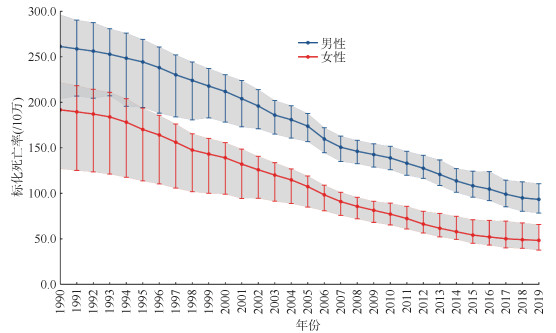
|
| 图 1 1990-2019年中国人群慢性阻塞性肺病分性别标化死亡率变化 |
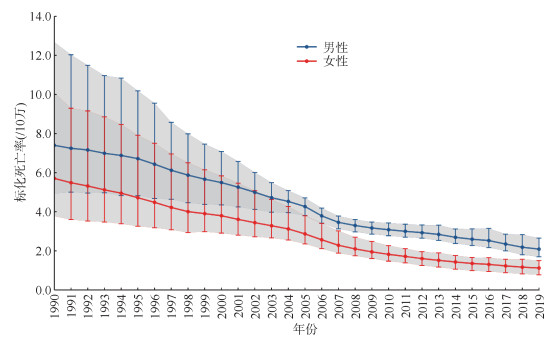
|
| 图 2 1990-2019年中国人群支气管哮喘分性别标化死亡率变化 |
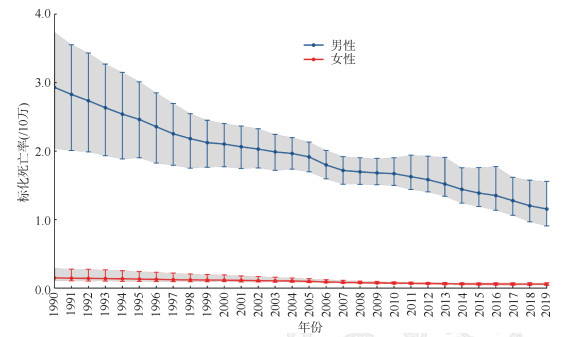
|
| 图 3 1990-2019年中国人群尘肺分性别标化死亡率变化 |

|
| 图 4 1990-2019年中国人群肺间质性疾病和肺结节病分性别标化死亡率变化 |
2. 不同种类CRD死亡人数的年度变化:1990-2019年COPD死亡人数和标化死亡率呈下降趋势(P < 0.001),死亡人数从1990年的124.4万(91.2万~139.5万)例降至2019年的103.7万(88.9万~126.6万)例,AAPC=-0.9%(95%CI:-1.5%~ -0.3%),P < 0.001;标化死亡率从1990年的217.9/10万(163.3/10万~242.0/10万)降至2019年的65.2/10万(55.5/10万~80.1/10万),AAPC=-4.2%(95%CI:-5.2%~-3.2%),P < 0.001。支气管哮喘死亡人数从1990年的4.0万(3.0万~5.8万)例降至2019年的2.5万(2.0万~3.1万)例,AAPC=-2.0%(95%CI:-2.6%~ -1.4%),P < 0.001;标化死亡率从1990年的6.4/10万(4.7/10万~9.5/10万)降至2019年的1.5/10万(1.2/10万~1.9/10万),AAPC=-5.1%(95%CI:-5.8%~ -4.4%),P < 0.001。尘肺死亡人数从1990年的1.1万(0.8万~1.4万)例降至2019年的1.0万(0.8万~1.4万)例,AAPC=-0.2%(95%CI:-0.4%~0.1%),P=0.200,无统计学意义;标化死亡率从1990年的1.4/10万(1.0/10万~1.7/10万)降至2019年的0.5/10万(0.4/10万~0.7/10万),AAPC=-3.1%(95%CI:-3.4%~ -2.8%),P < 0.001;肺间质性疾病和肺结节病死亡人数从1990年的0.3万(0.3万~0.6万)例增至2019年的0.8万(0.6万~1.0万)例,AAPC=3.5%(95%CI:2.7%~4.2%),P < 0.001;标化死亡率在1990-2019年变化不大,AAPC无统计学意义。见表 1。
3. 不同种类CRD死亡率的年龄别及性别差异:①COPD:1990年与2019年,COPD死亡率随年龄的增加呈上升趋势,在80~岁达到最高,男性高于女性,2019年我国不同人群COPD死亡率均低于1990年(图 5)。②支气管哮喘:1990年与2019年我国不同人群支气管哮喘死亡率均随年龄的增加呈上升趋势,50岁之后更加明显,男性高于女性,2019年我国不同人群支气管哮喘死亡率均低于1990年(图 6)。③尘肺:1990年与2019年,我国男性尘肺死亡率高于女性,且随年龄的增加呈上升趋势,我国不同人群尘肺死亡率与1990年相比均有所降低(图 7)。④肺间质性疾病和肺结节病:1990年与2019年肺间质性疾病和肺结节病死亡率随年龄增加呈上升趋势,男性高于女性,但2019年80~岁年龄组死亡率高于1990年(图 8)。
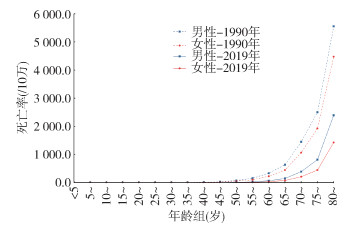
|
| 图 5 1990年与2019年不同性别不同年龄人群慢性阻塞性肺病死亡率 |

|
| 图 6 1990年与2019年不同性别不同年龄人群支气管哮喘死亡率 |
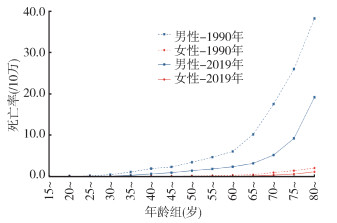
|
| 图 7 1990年与2019年不同性别不同年龄人群尘肺死亡率 |
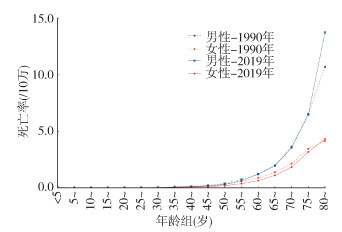
|
| 图 8 1990年与2019年不同性别不同年龄人群肺间质性疾病和肺结节病死亡率 |
4. CRD归因死亡情况:2019年男性因CRD而死亡的归因危险因素前5位依次为吸烟[71.1%(68.0%~74.3%)]、环境颗粒物污染[24.7%(20.1%~30.0%)]、职业性气体、微粒和烟雾[19.3%(13.0%~25.4%)]、低温[15.7%(13.6%~18.3%)]和被动吸烟[8.8%(4.5%~13.1%)]。1990-2019年环境颗粒物污染、臭氧污染、职业性接触二氧化硅和高BMI导致男性因CRD而死亡的PAF有所上升,高温和职业性接触石棉的PAF变化不大,其余6种危险因素的PAF均下降,其中室内空气污染降幅最大,由1990年的34.2%(20.6%~50.5%)降低至2019年的5.7%(2.5%~10.8%)。2019年女性因CRD而死亡的归因危险因素前5位依次为:环境颗粒物污染[24.1%(19.6%~29.3%)]、吸烟[21.9%(18.7%~25.2%)]、低温[16.4%(14.0%~19.2%)]、职业性气体、微粒和烟雾[15.6%(10.2%~21.1%)]和被动吸烟[14.7%(7.9%~21.3%)]。1990-2019年环境颗粒物污染、吸烟、臭氧污染、高BMI和职业性接触二氧化硅导致女性因CRD而死亡的PAF有所上升,高温、职业性接触石棉和职业性哮喘的PAF变化不大,其余4种危险因素的PAF均下降,其中室内空气污染降幅最大,由1990年的43.5%(29.2%~57.8%)降低至2019年的8.9%(4.3%~15.7%)。见表 2。
本研究结果显示,2019年我国CRD的死亡人数和标化死亡率均处于较高水平,由于我国人口基数庞大,CRD死亡患者占全球27.3%,与“一带一路”人口数超过9 000万的国家相比,我国CRD死亡人数位居第二,标化死亡率位居第三[8]。提示CRD仍是威胁我国人群健康的重要疾病。目前我国 < 70岁人群CRD标化死亡率为13.7/10万,与健康中国行动计划中“慢性呼吸系统疾病防治行动”中设定目标还有很大的差距,提示CRD防控任务艰巨。
近三十年以来,随着中国社会经济发展、医疗水平提高,我国COPD、支气管哮喘和尘肺死亡率均呈下降趋势,肺间质性疾病和肺结节病始终维持在较低水平,我国CRD死亡率下降的原因可能与几十年来我国居民经济和生活条件改善、居民营养状况增加、机体免疫力提高和危险因素的暴露因素减少有关。既往研究表明CRD的死亡率随着社会人口指数增高而降低[9]。COPD和支气管哮喘死亡率虽大幅度下降,但死亡人数远远超过尘肺、肺间质性疾病和肺结节病,并且1990-2019年我国人口老龄化的趋势日益严重,人口增长以及人口老龄化对这两类主要CRD所带来的挑战不容忽视。因此,未来应加强对高危人群进行肺功能检测,早期发现问题并对其进行干预。尘肺作为一种职业病,受接触粉尘的性质、浓度、接尘工龄、防护设施和个体防护用品以及职业卫生管理措施等多因素的影响,随着科学技术的不断发展,无尘作业环境、除尘设施以及防毒防尘面罩的广泛应用,我国尘肺的死亡率不断下降,未来应继续加强对作业环境进行监测,定期对接尘工人进行作业培训以及肺功能检测,从而进一步降低尘肺的死亡率。同时本研究结果还显示,1990-2019年肺间质性疾病和肺结节病的标化死亡率始终维持在较低水平,由于肺间质性疾病和肺结节病导致的死亡率随着社会人口指数的增加而增加,未来可能会给个人和社会带来更大的负担。因此,应加强肺间质性疾病和肺结节病患者管理。
2019年中国CRD死亡人数108.5万例,较1990年相比降低了16.6%,COPD、支气管哮喘和尘肺死亡人数均有所降低,而肺间质性疾病和肺结节病死亡人数却有所上升,这与Xie等[10]的研究结果一致。1990年与2019年不同种类的CRD死亡率均随年龄的增加呈上升趋势,同时我们还发现肺间质性疾病和肺结节病在80~岁年龄组死亡率高于1990年,这可能与期望寿命增加有关[11]。随着我国人口老龄化日趋严重,预计2030年我国65岁以上人口占比17.1%[12],表明CRD将会在一定时期内成为影响老年健康的重要疾病,未来应加强对CRD高龄患者的管理。
健康中国行动中CRD防治行动指出应通过控制CRD的相关危险因素,预防CRD的发生发展,提高患者预后和生活质量。本研究结果显示,不同危险因素对不同性别人群CRD死亡的PAF有较大差异,可能与职业暴露[13]、酒精饮用频率[14]、交通事故和工作事故[15]以及自身健康状况敏感程度[16]有关。与1990年相比,2019年我国不同性别人群室内空气污染、低温、职业性气体、微粒和烟雾以及被动吸烟所导致的PAF均有所下降,可能与清洁能源的使用、作业环境的改善以及生活习惯的改变有关,然而,职业性接触二氧化硅、高BMI、环境颗粒物污染以及臭氧污染所导致的PAF却有所增加,可能与我国工业化进程加快以及工业化所导致的空气污染有关。对于男性而言,2019年吸烟对CRD死亡的PAF与1990年比虽有一定的下降,但仍是导致CRD的最主要因素,近年来我国成年人吸烟率居高不下,且男性明显高于女性[17-20],研究显示吸烟导致死亡的男性比例正在进一步增加,预计至2030年,中国死于烟草使用的人数将高达200万[21],因此未来需要进一步加强控烟;对于女性而言,2019年环境颗粒物所导致的PAF最高,并且与1990年相比有所增加,研究表明空气污染与CRD的关系十分密切[22],同时降低环境污染也是世界卫生组织的行动之一[23],未来应继续加强对大气污染的控制;2019年,我国人群高BMI的PAF较1990年相比有所增加,可能与我国经济发展、居民生活方式的改变有关,未来应重视超重和肥胖的问题,防止由高BMI导致的PAF进一步增加。
本研究存在局限性。第一,本研究仅对GBD2019数据进行描述性分析,无法具体对CRD进行病因学分析;第二,既往研究表明COPD的主要危险因素具有明显的地区差异性[24],CRD在农村致死性疾病中位居第一位,在城市中位居第四位[25],然而本研究所用数据无法分析CRD疾病负担及危险因素的城乡差异;第三,CRD的发生和死亡受多种危险因素的影响,本研究只对12种主要危险因素进行了分析,由于遗传因素不可控制从而无法将其纳入分析。
随着医疗水平和生活质量的提高,人口老龄化不断增加,我国CRD的死亡仍处于较高水平。应继续实施三级预防的防控策略,针对危险因素对居民开展健康教育,普及肺功能检测,争取早日实现健康中国行动之CRD防治行动目标。
利益冲突 所有作者均声明不存在利益冲突
作者贡献声明 龙政、刘威:数据分析、论文撰写;齐金蕾、刘韫宁、刘江美、由金玲、林琳:数据整理、统计学分析;王黎君、周脉耕、殷鹏:研究指导、论文修改、经费支持
| [1] |
中国疾病预防控制中心慢性非传染性疾病预防控制中心, 国家卫生健康委统计信息中心. 中国死因监测数据集-2019[M]. 北京: 中国科学技术出版社, 2020. Center for Chronic Non-communicable Disease Control and Prevention, Chinese Center for Disease Control and Prevention, Statistical Information Center of National Health Commission. Cause of death surveillance dataset of China-2019[M]. Beijing: China Science and Technology Press, 2020. |
| [2] |
胡建平, 饶克勤, 钱军程, 等. 中国慢性非传染性疾病经济负担研究[J]. 中国慢性病预防与控制, 2007, 15(3): 189-193. Hu JP, Rao KQ, Qian JC, et al. The study of economic burden of chronic non-communicable diseases in China[J]. Chin J Prev Control Chron Non-Commun Dis, 2007, 15(3): 189-193. DOI:10.3969/j.issn.1004-6194.2007.03.001 |
| [3] |
GBD 2019 Diseases and Injuries Collaborators. Global burden of 369 diseases and injuries in 204 countries and territories, 1990-2019: a systematic analysis for the Global Burden of Disease Study 2019[J]. Lancet, 2020, 396(10258): 1204-1222. DOI:10.1016/S0140-6736(20)30925-9 |
| [4] |
GBD 2019 Risk Factors Collaborators. Global burden of 87 risk factors in 204 countries and territories, 1990-2019: a systematic analysis for the Global Burden of Disease Study 2019[J]. Lancet, 2020, 396(10258): 1223-1249. DOI:10.1016/S0140-6736(20)30752-2 |
| [5] |
GBD 2019 Demographics Collaborators. Global age-sex- specific fertility, mortality, healthy life expectancy (HALE), and population estimates in 204 countries and territories, 1950-2019: a comprehensive demographic analysis for the Global Burden of Disease Study 2019[J]. Lancet, 2020, 396(10258): 1160-1203. DOI:10.1016/S0140-6736(20)30977-6 |
| [6] |
GBD 2019 Viewpoint Collaborators. Five insights from the global burden of disease study 2019[J]. Lancet, 2020, 396(10258): 1135-1159. DOI:10.1016/S0140-6736(20)31404-5 |
| [7] |
董景五. 疾病和有关健康问题的国际统计分类[M]. 北京: 人民卫生出版社, 2008. Dong JW. International statistical classification of diseases and related health issues[M]. Beijing: People's Medical Publishing House, 2008. |
| [8] |
Institute for Health Metrics and Evaluation. GBD 2019 Resources. (2020-10)[2021-05-16]. http://www.healthdata.org/gbd/gbd-2019-resources.
|
| [9] |
GBD 2016 Causes of Death Collaborators. Global, regional, and national age-sex specific mortality for 264 causes of death, 1980-2016: a systematic analysis for the Global Burden of Disease Study 2016[J]. Lancet, 2017, 390(10100): 1151-1210. DOI:10.1016/S0140-6736(17)32152-9 |
| [10] |
Xie M, Liu XS, Cao XP, et al. Trends in prevalence and incidence of chronic respiratory diseases from 1990 to 2017[J]. Respir Res, 2020, 21(1): 49. DOI:10.1186/s12931-020-1291-8 |
| [11] |
Lin HH, Murray M, Cohen T, et al. Effects of smoking and solid-fuel use on COPD, lung cancer, and tuberculosis in China: a time-based, multiple risk factor, modelling study[J]. Lancet, 2008, 372(9648): 1473-1483. DOI:10.1016/S0140-6736(8)61345-8 |
| [12] |
邱杨. 我国人口老龄化对医疗支出的影响研究[J]. 人口与社会, 2015, 31(2): 95-102. Qiu Y. How China's population aging affected medical expense in China[J]. Popul Soc, 2015, 31(2): 95-102. DOI:10.14132/j.2095-7963.2015.02.013 |
| [13] |
Bonifazi M, Gasparini S, Alfieri V, et al. Pulmonary sarcoidosis[J]. Semin Respir Crit Care Med, 2017, 38(4): 437-449. DOI:10.1055/s-0037-1603766 |
| [14] |
许晓丽, 赵丽云, 房红芸, 等. 2010-2012年中国15岁及以上居民饮酒状况[J]. 卫生研究, 2016, 45(4): 534-537, 567. Xu XL, Zhao LY, Fang HY, et al. Status of alcohol drinking among population aged 15 and above in China in 2010-2012[J]. J Hyg Res, 2016, 45(4): 534-537, 567. DOI:10.19813/j.cnki.weishengyanjiu.2016.04.005 |
| [15] |
王博宇, 李杰伟. 中国交通事故的统计分析及对策[J]. 当代经济, 2015(20): 116-119. Wang BY, Li JW. Statistical analysis and countermeasures of Chinese traffic accidents[J]. Contempor Econom, 2015(20): 116-119. DOI:10.3969/j.issn.1007-9378.2015.20.052 |
| [16] |
Wang SB, Ungvari GS, Forester BP, et al. Gender differences in general mental health, smoking, drinking and chronic diseases in older adults in Jilin province, China[J]. Psychiatry Res, 2017, 251: 58-62. DOI:10.1016/j.psychres.2017.02.007 |
| [17] |
Li XC, Cao XP, Guo MZ, et al. Trends and risk factors of mortality and disability adjusted life years for chronic respiratory diseases from 1990 to 2017: systematic analysis for the Global Burden of Disease Study 2017[J]. BMJ, 2020, 368: m234. DOI:10.1136/bmj.m234 |
| [18] |
Wang C, Xu JY, Yang L, et al. Prevalence and risk factors of chronic obstructive pulmonary disease in China (the China Pulmonary Health study): a national cross-sectional study[J]. Lancet, 2018, 391(10131): 1706-1717. DOI:10.1016/S0140-6736(18)30841-9 |
| [19] |
Wang MH, Luo X, Xu SB, et al. Trends in smoking prevalence and implication for chronic diseases in China: serial national cross-sectional surveys from 2003 to 2013[J]. Lancet Respir Med, 2019, 7(1): 35-45. DOI:10.1016/S2213-2600(18)30432-6 |
| [20] |
王宁, 冯雅靖, 包鹤龄, 等. 2014年中国40岁及以上人群吸烟现状调查[J]. 中华流行病学杂志, 2018, 39(5): 551-556. Wang N, Feng YJ, Bao HL, et al. Survey of smoking prevalence in adults aged 40 years and older in China, 2014[J]. Chin J Epidemiol, 2018, 39(5): 551-556. DOI:10.3760/cma.j.issn.0254-6450.2018.05.003 |
| [21] |
Chen ZM, Peto R, Zhou MG, et al. Contrasting male and female trends in tobacco-attributed mortality in China: evidence from successive nationwide prospective cohort studies[J]. Lancet, 2015, 386(10002): 1447-1456. DOI:10.1016/S0140-6736(15)00340-2 |
| [22] |
杨静, 殷鹏, 曾新颖, 等. 2006-2016年中国室外空气污染的归因死亡分析[J]. 中华流行病学杂志, 2018, 39(11): 1449-1453. Yang J, Yin P, Zeng XY, et al. Deaths attributed to ambient air pollution in China between 2006 and 2016[J]. Chin J Epidemiol, 2018, 39(11): 1449-1453. DOI:10.3760/cma.j.issn.0254-6450.2018.11.006 |
| [23] |
World Health Organization. How air pollution is destroying our health[EB/OL]. https://www.who.int/airpollution/news-and-events/how-air-pollution-is-destroying-our-health.
|
| [24] |
廖清, 陶玉坚. 慢性阻塞性肺疾病流行病学及危险因素研究现状[J]. 中华临床医师杂志: 电子版, 2018, 12(8): 468-471. Liao Q, Tao YJ. Research status on epidemiology of and risk factors for chronic obstructive pulmonary disease[J]. Chin J Clin: Electr Ed, 2018, 12(8): 468-471. DOI:10.3877/cma.j.issn.1674-0785.2018.08.008 |
| [25] |
Zhong NS, Wang C, Yao WZ, et al. Prevalence of chronic obstructive pulmonary disease in China: a large, population-based survey[J]. Am J Respir Crit Care Med, 2007, 176(8): 753-760. DOI:10.1164/rccm.200612-1749OC |
 2022, Vol. 43
2022, Vol. 43




